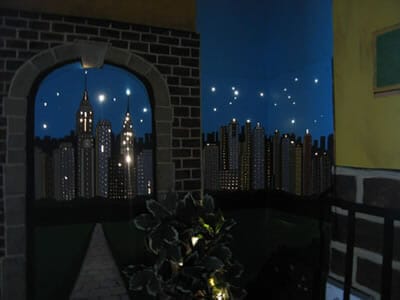Most of the fibre optics that we sell end up in ceilings, but fibre optic lighting can also be used to good effect on the walls, as in this interesting project by artist Val Cansick. Val is in demand as a designer of customised bedroom decor for children, and recently produced this scheme which is based on the skyline of New York City.
She wanted to bring the skyscrapers to life by illuminating their windows, and approached Starscape to discuss how this might be achieved using fibre optics.
In the end Val opted to simply buy a standard Orion kit, which she reckoned provided enough in terms of fibre numbers and fibre lengths, but we suspect that on a future job she’d probably opt for a custom harness or simply buy fibre on the spool and cut it herself.

Val used the 120 fibres in the Orion harness to illuminate two wall panels, using the sideglow effect of the fibres to illuminate windows in the skyscrapers and the end
points of the fibres for stars and other lights. The light source, painted to blend in with the mural, can be seen below the cluster of artificial leaves which help to hide the thick glowing “tail” of fibres leading from the light source to the panels.
“I laid the fibres in rows behind the holes having used sandpaper lightly along the fibres to allow the light to leak out more along the lengths,” explained Val. “That way I didn’t have to have one fibre per hole as it would have been too bulky to have that many fibres behind the panel.
I also wanted the windows to vary in intensity of light, as you would see in a skyline.
I brought the end of some fibres out at the top of the buildings such as the Empire State and the
Chrysler building to act as the warning lights you see for aircraft on tall buildings. I also ran a few of the fibres in and out of holes vertically where there was a strip of light on the real buildings as per research photos I looked at. So you can weave the sandpapered fibres in and out for different effects. As you can see, I also ran the fibre ends to create the stars above the buildings so they worked exactly as intended.
“I had the light source connected up while I was working most of the time to make sure that when
I stuck the fibres down, they were bang in the middle of the window openings,” said Val. “Fiddly, as you can imagine, but it worked.
“I hid the fibres running to the light source by putting an ivy bush in front of it – artificial leaves that
I fixed to the wall with ‘no-nails’ tape. It is also safe from children messing with the light source as Mum takes the connecting electric cable out when the kids are unsupervised.

“The little boy has moved into the bedroom without any trouble – he won’t get out of bed now in the mornings!” reports Val. “The street lamp has been installed as a dimmable night light, but the child loves the changing lights of the fibre-optic panels and so they are his favourite.
“I learned a lot and am looking at other materials presently to use in the future. I love the way the fibres don’t show in the daylight hours, so it is a complete surprise when you turn on the illuminations!”
